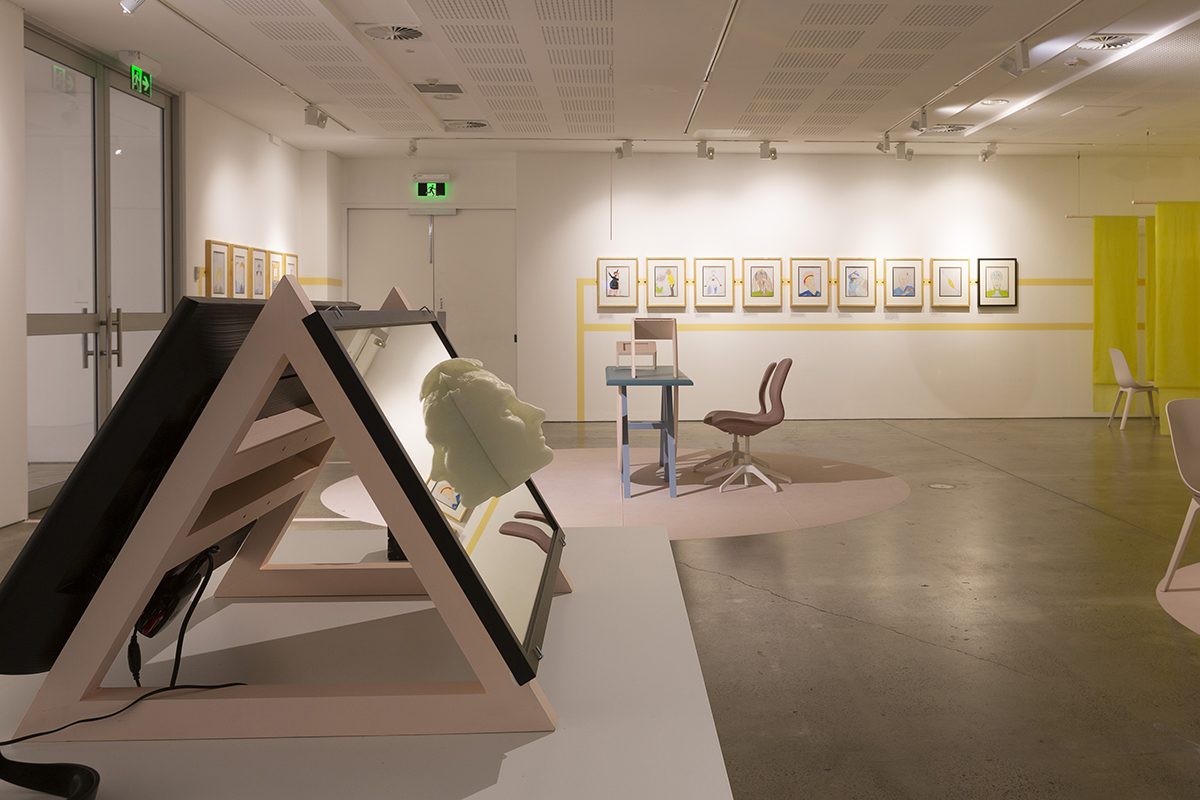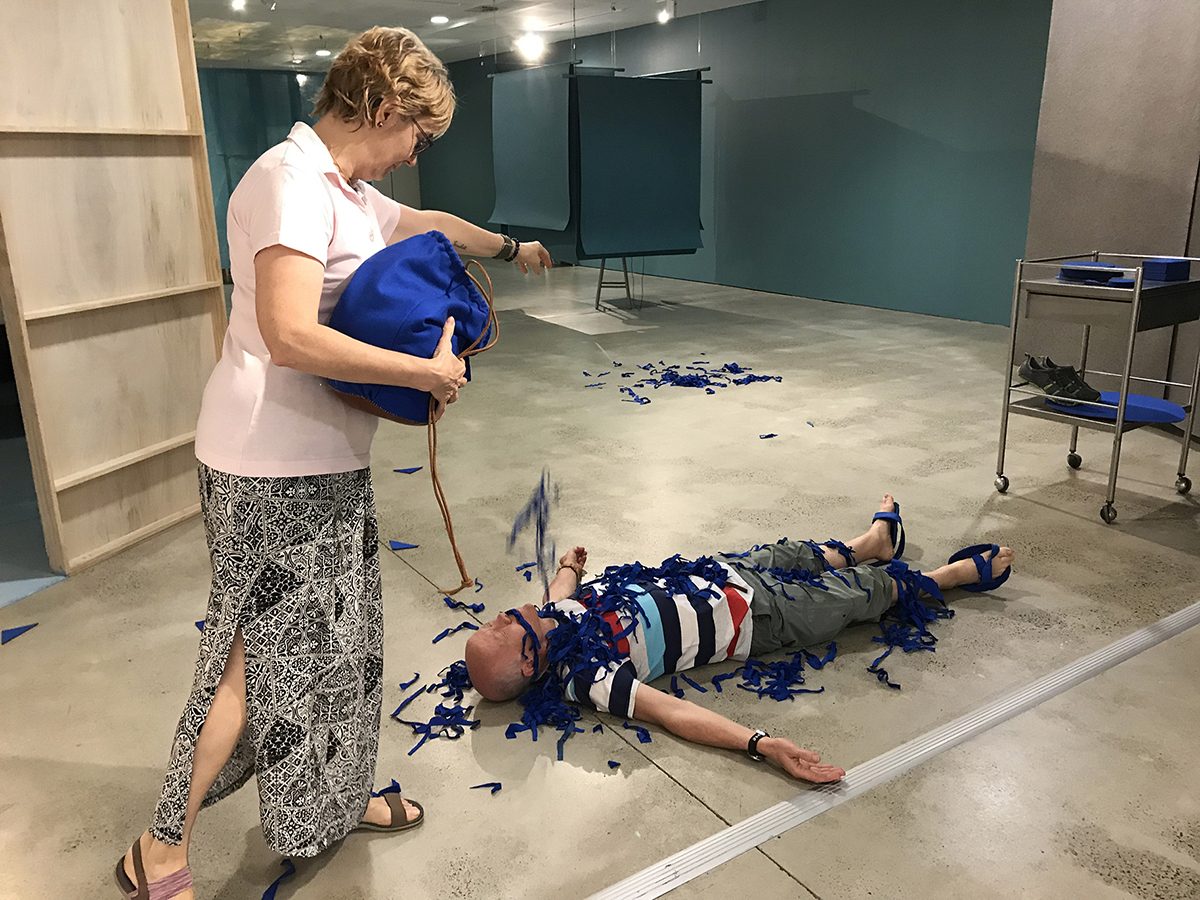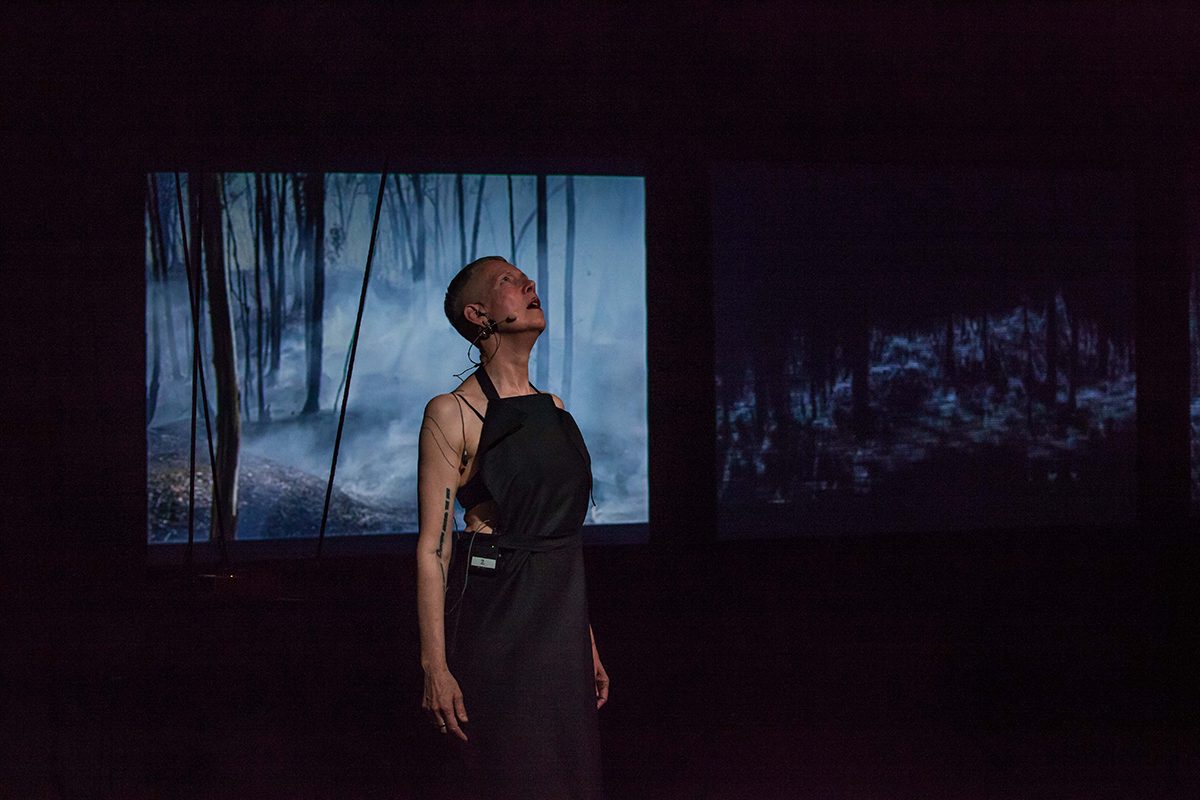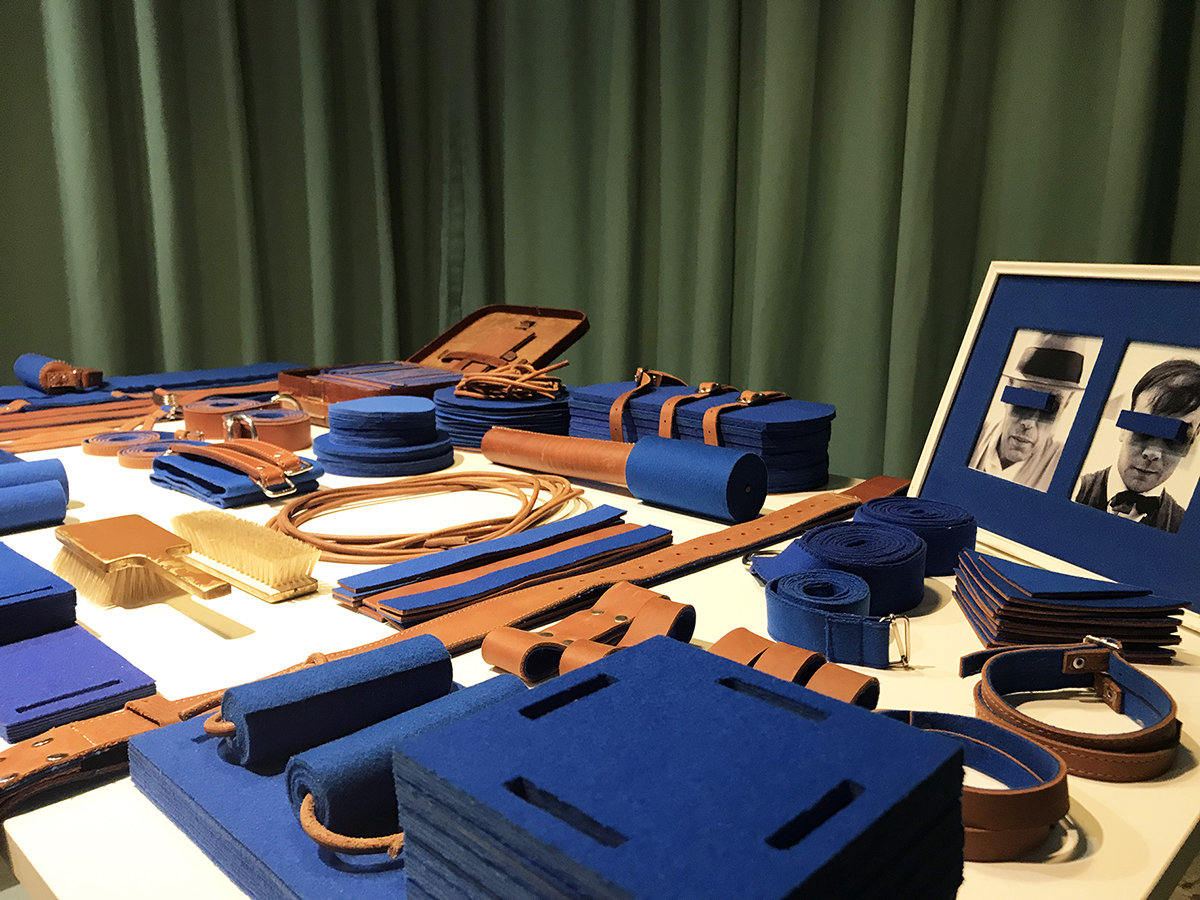
The Big Anxiety 3: Altering states
In addition to my accounts of experiencing r e a and Judy Atkinson’s listen_UP and Eugenie Lee’s Breakout My Pelvic Sorcery, here’s a cluster of other works in The Big Anxiety’s The Empathy Clinic by artists Sam Kerr-Phillips, Vic McEwan, Debra Keenahan and Jason Maling. In his clinic, The Physician, Maling wrily helps visitors find tools for coping with the challenges of the contemporary art experience; it’s not about empathy, but does reveal what we as gallery-goers can suffer. Elsewhere in The Big Anxiety at UNSW Galleries, Alex Davies and Michaela Davies’ VR work Edge of the Present also addresses coping, with the very struggle to want to live. At the Esme Timbery Creative Practice Lab at UNSW Kensington, Rupture, a performative installation, searches for agency in the face of urgency in catastrophic times.
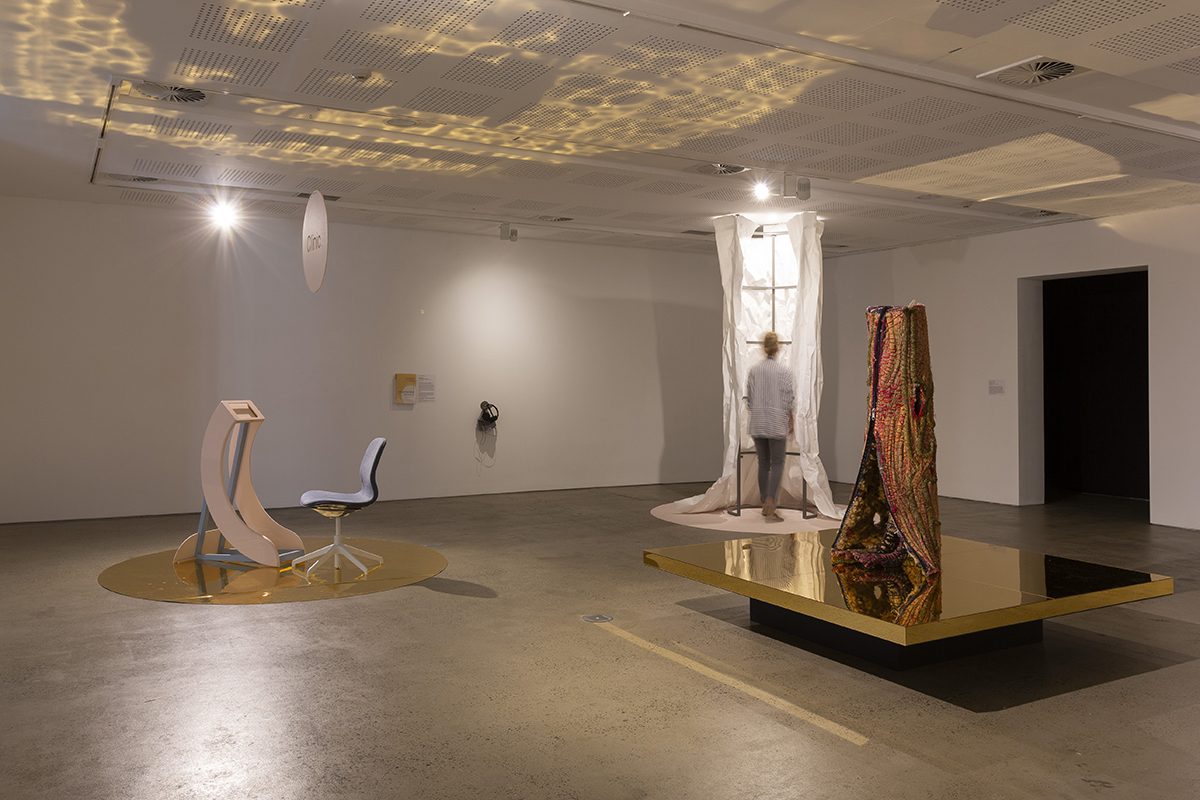
Foreground: Ngangkari Tjukurpa (Traditional Healer Tjukurpa), 2013, Ken and Naomi Kantjuriny from the MCA Collection, photo Jessica Maurer
Despite spending many hours engaging with The Big Anxiety, I regret being able to access only a little of two VR works by fEEL (Felt Experience & Empathy Lab UNSW) and Uti Kulintjaku “an Aboriginal-led mental health literacy project that takes its name from a Pitjantjatjara phrase that means ‘to listen, think and understand clearly’,” formed by Ngangkari traditional healers and artists of the NPY Women’s Council, Alice Springs. The project uses an old story of a man trapped in a hollow log who is rescued by his wives as a healing metaphor for dealing with male depression and contingent violence and alcoholism. As Kim Mahood has written in The Monthly, “Embedded in cultural memory, the story of The Man in the Log provides a psychological traction that’s missing from Western approaches to Aboriginal mental health.” Accompanying the VR work is another representation of the story, the exquisite sculpture Ngangkari Tjukurpa (Traditional Healer Tjukurpa), 2013, by Ken and Naomi Kantjuriny from the MCA Collection.
SO IT BEGINS
An intimate, curtained space. A single chair. To the left a video, SO IT BEGINS (2017); to the right a large printed copy of the poem haltingly heard within a deeply textured soundtrack. The 11-minute video comprises a stream of photographs of the complex life of the artist flowing rhythmically towards a bitter truth: “a boy loses his father and his own life as he knows it” (program); as the closing line of the poem puts it, “So it begins…” The WA artist-filmmaker Sam Kerr-Phillips, who uses a powered wheelchair for mobility, wins our deep attention to trauma and enduring but considered grief with the interplay between everyday screen images and a vivid evocation of a twilight motorbike ride that would end fatally: “Blood orange brushstrokes stole our attention./ Two suckers for sunsets round the bend captivated./ BAM! Kissed the arse of a stubborn four-wheeled rhino!”
If They Spend Time To Get To Know Me
This intriguing installation, with its death mask-like sculptures, onscreen facial mappings and reflective voices, conveys a disturbing impression of the social stigma and psychological pain felt by sufferers of facial nerve paralysis. An apparent absence of responsiveness can be read as inattentiveness, indifference or hostility by those eagerly ‘reading’ for immediate meaning. If They Spend Time To Get To Know Me is part of PhD research by Vic McEwan, Artistic Director of The Cad Factory in regional NSW, in partnership with researchers, surgeons and patients from the Sydney Facial Nerve Clinic.
Arts, Health and Healing, a Sydney University Sydney Ideas and related Big Anxiety event held on 21 October, launched a major initiative, the NSW-ACT Arts Health Network with talks by Vic McEwan, Dr Clive Parkinson, Manchester School of Art, Dr Nicole Reilly, University of Newcastle (UON) and Akeshia Dart, mental health clinician and PhD candidate UON, chaired by Dr Claire Hooker, University of Sydney. These speakers provided fascinating perspectives on how artists work within hospitals, government misconceptions about what art can do, equity of (art) access issues for the ill, and strategies for improving the mental health of young Indigenous mothers through toy-making. Parkinson’s painfully personal, poetic account of the art and health terrain evoked hospitals as temples to culture, places where artists can provide succour if not cures, is especially worth a hearing. You can listen to the whole event here.
The Physician
I’ve booked for a session with The Physician. The work is described as “a public health program developed and facilitated by artist Jason Maling. Through a client focused one-on-one process and utilising a set of bespoke tools Maling addresses latent issues of cultural anxiety.” At first sight the tools are a little alarming: a rich variety of straps, belts, pads, balls and tubes are laid out neatly on a table. And there’s a consulting room bed. Refined S&M? In the low-lit room these objects glow an intensely Kleinian blue, some reinforced with burnished leather, all crafted by the artist. On the desk are small, framed photos of the artist’s heroes, Yves Klein and Joseph Beuys, the eyes of each covered with a blue strip.
Maling, in Bueysean felt trousers, is a reassuring presence, eloquently introducing his tools and inviting me to feel their texture and shape and to try them out. Surprisingly, these are devices designed to help gallery goers cope with the art experience. As Maling writes on his The Physician page, “Contemporary Art Institutions are beginning to recognise the need to provide onsite services that address the gamut of contemporary anxieties, ranging from mild conceptual perturbation to severe relational deficiency.”
I admire a felt-padded leather headband with which, if distressed, you can lean your forehead against a gallery wall for pause. If meaning threatens to dissipate, with your foot you can push a roller ahead with a renewed sense of purpose. There are even soft hitting devices, presumably to encourage attentiveness, and a bag of offcuts (see image above). Unable to hit on any particular anxiety, I focus on the back pain inevitable in long gallery visits and choose a wide, tight tube with which I’m held erect and ready to go on an art stroll with the artist. We are linked by a skipping rope-like cord (blue handles) as we walk, discussing the meta-subjectivity of the already subjective aesthetic experience.
It should have immediately occurred to me that I’d been in the same Empathy Clinic room the week before with another belt around my waist, experiencing simulated pelvic pain in artist Eugenie Lee’s Breakout My Pelvic Sorcery. Perhaps Maling’s was the therapy I needed to “clear unwanted metaphoric deposits and restore full socio-poetic function.”
The same band can also be worn around the head to block out or restrict art intake. Photographs on Maling’s The Physican page and the one above reveal the extent Maling’s ‘patients’ will go to manage the contemporary art experience. Galleries and gallery-goers are taking on his “Beuysenklein voidal dematerialization.” Exquisitely crafted, The Physician, for all its drollery rings true as contemporary art grows more ‘experiential.’ Ironically, the work doubles as a gallery experience of that very kind and critique of same.
Being Debra
Debra Keenahan’s PhD research “focuses upon developing a Critical Disability Aesthetic through the representation of the female dwarf.” Being Debra offers users “an embodied experience of having dwarfism in contemporary Australian society, thus potentially increasing empathy for a physical difference not readily emulated.” It’s a VR work that reveals how vastly different the physical world and social relations are defined by height. In one frightening scene Debra is abused by a group of overbearing teenagers. In another, hospital staff discuss her in the third person. While in the previous scene we shared Debra’s eye-level point of view, here the camera is positioned at waist level so that her legs reach out before us as if they’re our own, an even more heightened subjectivity. With this comes a feeling of vulnerability that brings home Keenahan’s adroit use of VR to dramatically and, at times wittily, reconfigure perception and prejudice. Being Debra is doubly potent, as both an artistic expression of Keenahan’s experience and an invitation to enter a vivid simulacrum of it.
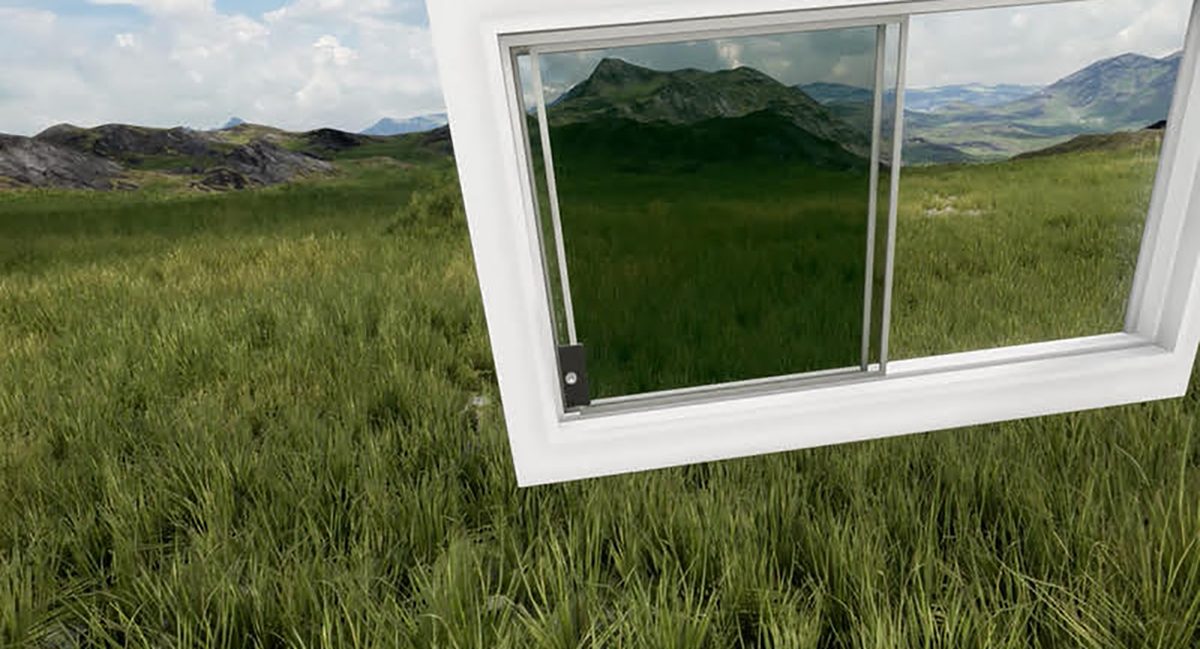
Promotional image, Edge of the Present, Alex Davies and Michaela Davies, The Big Anxiety, courtesy the artists
Edge of the Present
I enter a white room. VR gear is fitted and activated. It’s the same room, both actual and virtual. I open a real/virtual door to a not-real pine treed landscape; the scale and depth takes me by surprise. Back inside I notice rocks and growth on the floor. I look out a window at a similar view, turn and find the scattered grass is knee-high and denser. Snow is falling outside, and inside! I turn again and the room disappears. I’m fully outside on a vast snowy terrain. I gasp, briefly agoraphobic. Then comes exhilaration. An undefinable breakthrough. The work’s epic 10 minutes is over, but the sense of pleasure and release lingers long after.
The makers, media artist Alex Davies and artist and psychologist Michaela Davies hope that “by using technology in this novel [actual-virtual] way, the installation helps viewers to better engage with the present moment— and hence with the future—with openness, curiosity, and confidence.” They reveal a more precise goal: “[M]ade in collaboration with psychologists, mental health specialists and participants with lived experiences of suicide survival…this immersive experience invites us to ‘invent the next 10 minutes’—something that is a challenge when we find ourselves inhabiting the ‘edge of the present’.” The NHMRC Centre for Research Excellence in Suicide Prevention/Black Dog Institute also offered guided sessions of Edge of the Present. It’d be fascinating to hear what participants gained from this aesthetic experience, with all its multidisciplinary underpinnings.
Rupture
At UNSW’s impressive new Esme Timbery Creative Practice Lab, Virginia Barratt extended her text, vocal and physical presence on video in photomedia artist Jessie Boylan’s multi-screen installation Rupture (Bendigo Regional Art Gallery, 2018) into live performance as an unnerving shamanistic figure, eyes rolling up, the real body painfully in and out of sync with a quivering, unstable virtual self and in beautiful chorus with voices in flight. Made in collaboration with Boylan, media artist Linda Dement and trauma counsellor and psychotherapist Jenna Tuke, Rupture as performance dramatically evokes panicky transference between the individual and the natural and social world, each enduring serial trauma. Barratt roots her response in a recollection of her child self in horrified awe of the cosmos but feeling inextricably tied to it (“I am a star, the star is me”).
A sense of desolation, where not even friendship can console, is relentlessly evoked as smoke drifts through bush, hundreds of scrolling words spell out environmental and other horrors and we are drawn into an endlessly deep, metallic tunnel, while Barratt’s virtual body fragments and the real self fades into shadow.
What, in this panicky scenario, is the shaman’s message? I recall in particular one gnomic utterance: “Dissolution…is a gift that keeps giving but has to be taken.” Presumably, we surrender to our condition or learn from and manage it, as best we can. Revealing the extremity of that condition, a very personal one but shared to varying degrees, Rupture was cathartic for some in its audience, or, for all its hyper-expressiveness, was just too painfully real for others. I left oscillating between these states, unable to answer the question posed by the artists in their program note: “By considering panic as both urgency and agency, can we begin to see ways of engaging with our catastrophic times?” But I keep worrying at it; Rupture has that kind of power.
Andrew Stephens’ review for Artlink of the original installation in Bendigo will give you a more comprehensive sense of Jessie Boylan’s imagery than I have space for here. Take a look also at an excerpt from Ngurini (Searching), a collaboration between Boylan, Dement, Paul Brown and the Pitjantjatjara Anangu people about the legacy of trauma caused by Britain’s atomic testing at Maralinga in South Australia.
–
The Big Anxiety, first staged in 2017, is a festival that “brings together artists, scientists and communities to question and re-imagine the state of mental health in the 21st century” (website). Artistic and Executive Director Professor Jill Bennett (UNSW), Producer Tanja Farman, Senior Curator Bec Dean.
The Big Anxiety, The Empathy Clinic, curators Bec Dean, Jill Bennett, works by Sam Kerr-Phillips, Vic McEwan, Debra Keenahan, Jason Maling; Alex Davies and Michaela Davies, UNSW Galleries, 27 Sept-16 Nov; Rupture, collaborators Jessie Boylan, Virginia Barratt, Linda Dement and Jenna Tuke, Esme Timbery Creative Practice Lab, UNSW, Sydney, 31 Oct
Top image credit: The Physician, Jason Maling, The Big Anxiety, photo courtesy the artist


